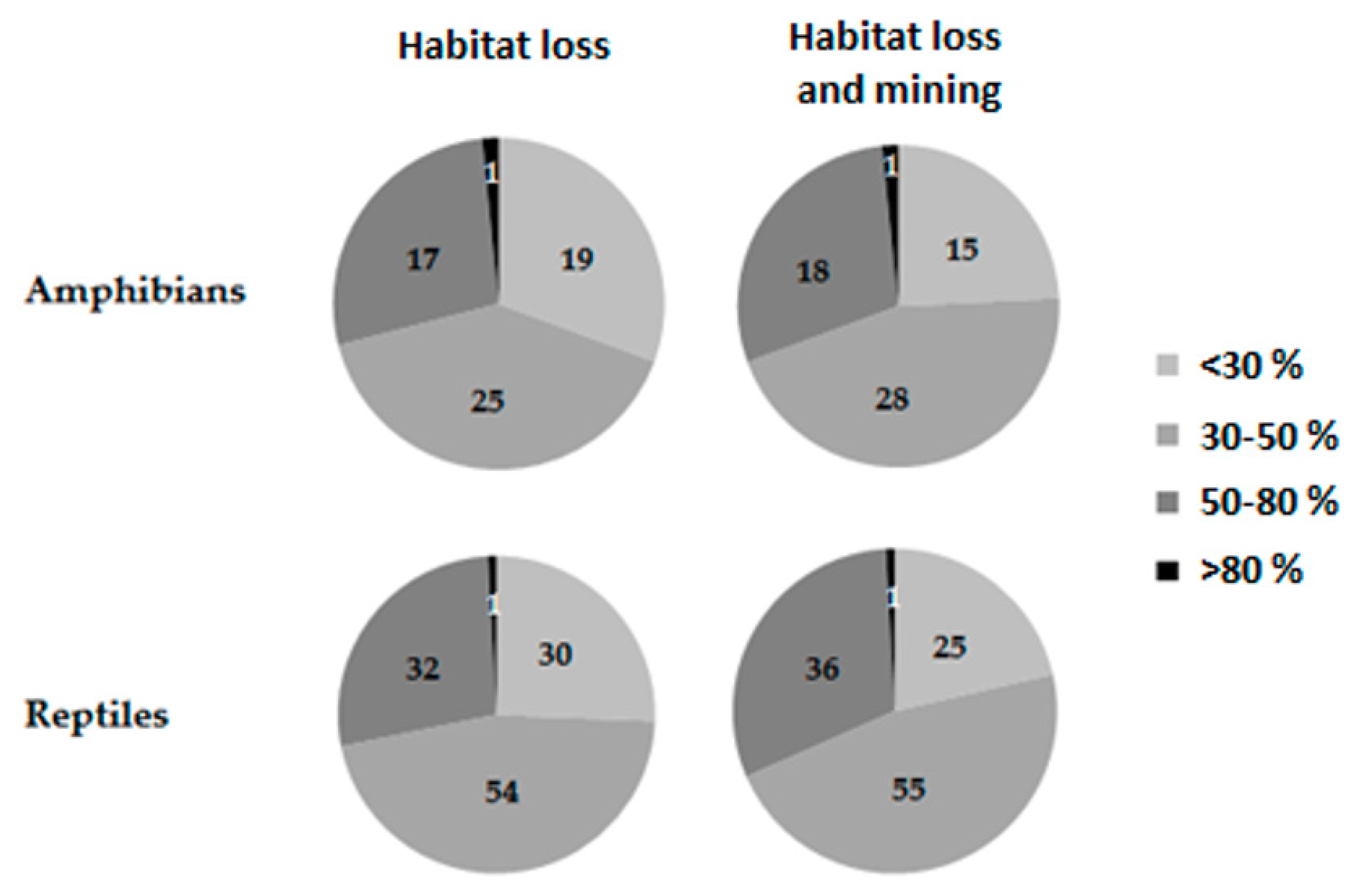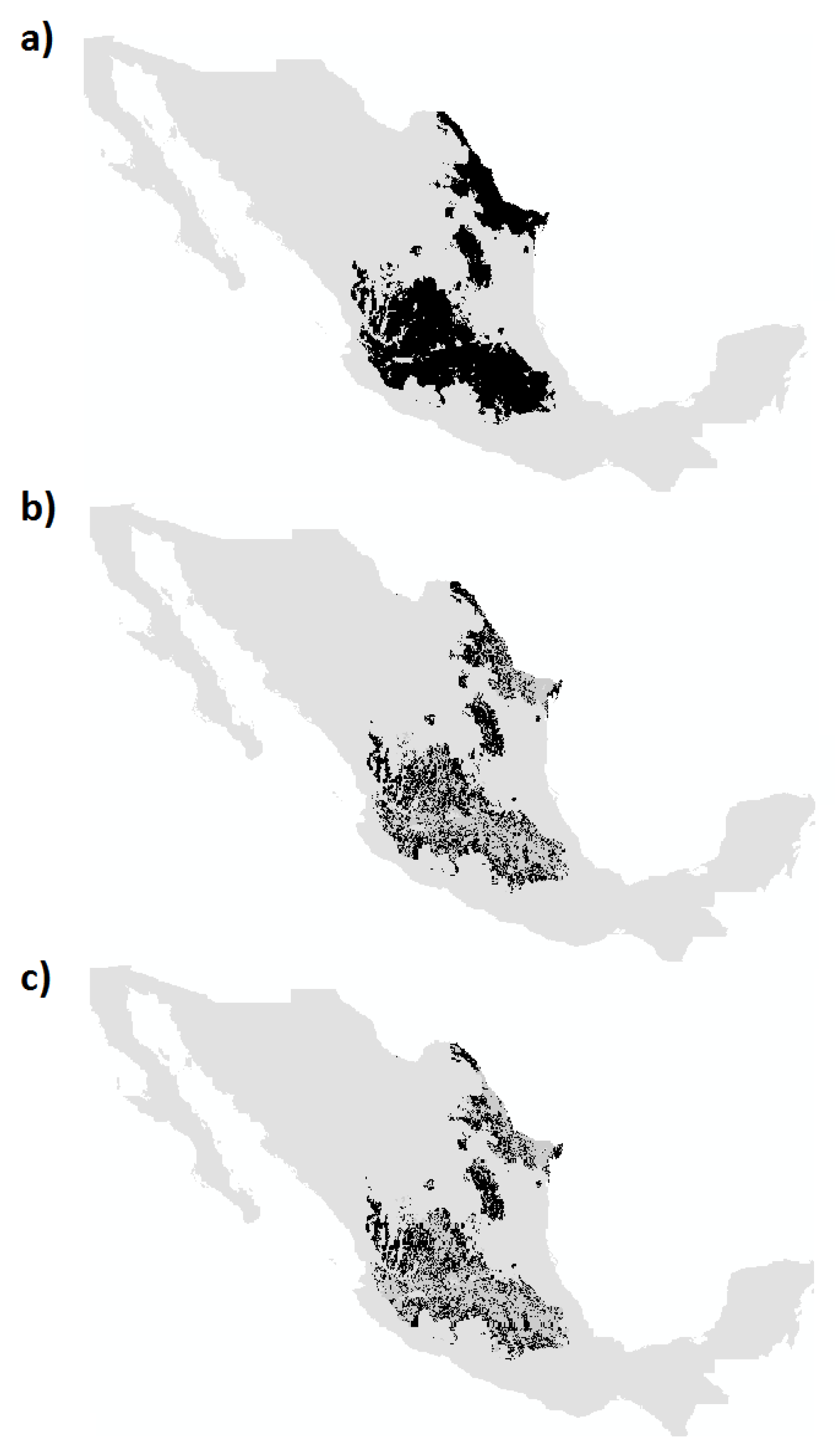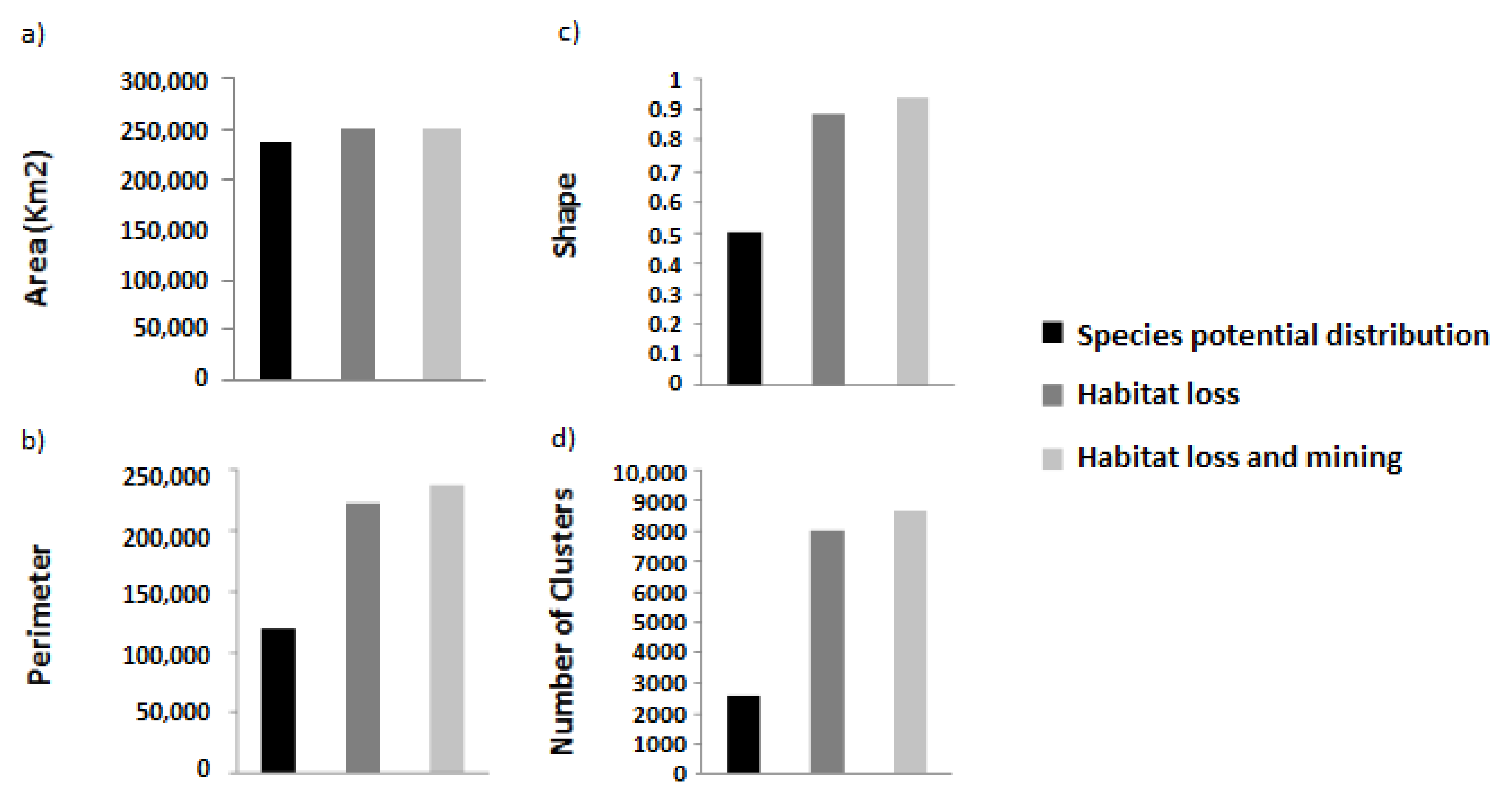Impact of Habitat Loss and Mining on the Distribution of Endemic Species of Amphibians and Reptiles in Mexico
Abstract
:1. Introduction
2. Materials and Methods
2.1. Point Occurrence Data
2.2. Potential Species Distributions
2.3. Extant Species Distributions
2.4. Selection of Priority Areas for Conservation
2.5. Statistical Analysis
3. Results
3.1. Extant Species Distributions
3.2. Conservation Area Network under Three Scenarios
4. Discussion
Supplementary Materials
Author Contributions
Funding
Acknowledgments
Conflicts of Interest
References
- SEMARNAT. Informe de la Situación del Medio Ambiente en México. Compendio de Estadísticas Ambientales. Indicadores Clave, de Desempeño Ambiental y de Crecimiento Verde; Edición 2015; Semarnat: Mexico City, México, 2016.
- Flores-Villela, O.; García-Vázquez, U.O. Biodiversidad de Reptiles en México. Rev. Mex. Biodivers. 2014, 85, 31. [Google Scholar] [CrossRef]
- Olea, G.P.; Flores-Villela, O.; Almeralla, C.M. Biodiversidad de Anfibios en México. Rev. Mex. Biodivers. 2014, 85, 33. [Google Scholar]
- IUCN. IUCN Red List of Threatened Species 2006; International Union for the Conservation of Nature (IUCN): Gland, Switzerland, 2006. [Google Scholar]
- Stuart, S.N.; Chanson, J.S.; Cox, N.A.; Young, B.E.; Rodrigues, A.S.L.; Fischman, D.L.; Waller, R.W. Status and Trends of Amphibian Declines and Extinctions Worldwide. Science 2004, 306, 1783–1786. [Google Scholar] [CrossRef] [Green Version]
- Beebee, T.J.C.; Griffiths, R.A. The Amphibian Decline Crisis: A Watershed for Conservation Biology? Biol. Conserv. 2005, 125, 271–285. [Google Scholar] [CrossRef]
- Baillie, J.E.M.; Hilton-Taylor, C.; Stuart, S.N. 2004 IUCN Red List of Threatened Species. A Global Species Assessment; IUCN: Gland, Switzerland; Cambridge, UK, 2004. [Google Scholar]
- Gibbons, J.W.; Scott, D.E.; Ryan, T.J.; Buhlmann, K.A.; Tuberville, T.D.; Metts, B.S.; Greene, J.L.; Mills, T.; Leiden, Y.; Poppy, S.; et al. The Global Decline of Reptiles, Déjà Vu Amphibians: Reptile Species are Declining on a Global Scale. Six Significant Threats to Reptile Populations are Habitat Loss and Degradation, Introduced Invasive Species, Environmental Pollution, Disease, Unsustainable Use, and Global Climate Change. Bioscience 2000, 50, 653–667. [Google Scholar] [CrossRef]
- Broomhall, S.D.; Osborne, W.S.; Cunningham, R.B. Comparative Effects of Ambient Ultraviolet-B Radiation on Two Sympatric Species of Australian Frogs. Conserv. Biol. 2000, 14, 420–427. [Google Scholar] [CrossRef]
- Kiesecker, J.M.; Blaustein, A.R.; Belden, L.K. Complex Causes of Amphibian Population Declines. Nature 2001, 410, 681–684. [Google Scholar] [CrossRef]
- Hecnar, S.J. Acute and Chronic Toxicity of Ammonium Nitrate Fertilizer to Amphibians from Southern Ontario. Environ. Toxicol. Chem. Int. J. 1995, 14, 2131–2137. [Google Scholar] [CrossRef]
- Davidson, C.; Shaffer, H.B.; Jennings, M.R. Declines of the California Red-Legged Frog: Climate, UV-B, Habitat, and Pesticides Hypotheses. Ecol. Appl. 2001, 11, 464–479. [Google Scholar] [CrossRef]
- Gardner, T.A.; Barlow, J.; Peres, C.A. Paradox, Presumption and Pitfalls in Conservation Biology: The Importance of Habitat Change for Amphibians and Reptiles. Biol. Conserv. 2007, 138, 166–179. [Google Scholar] [CrossRef]
- Becker, C.G.; Fonseca, C.R.; Baptista-Haddad, C.F.; Fernándes-Batista, R.; Prado, P.I. Habitat Split and the Global Decline of Amphibians. Nature 2007, 318, 1775–1777. [Google Scholar] [CrossRef] [Green Version]
- Sarukhán, J.; Koleff, P.; Carabias, J.; Soberón, J.; Dirzo, R.; Llorente-Bousquets, J.; Halffter, G.; González, R.; March, I.; Mohar, A.; et al. Capital Natural de México. Síntesis: Conocimiento Actual, Evaluación y Perspectivas de Sustentabilidad; Comisión Nacional Para el Conocimiento y Uso de la Biodiversidad: Mexico City, México, 2009. [Google Scholar]
- Botello, F.; Sánchez-Cordero, V.; Ortega-Huerta, M.A. Disponibilidad de Hábitats Adecuados Para Especies de Mamíferos a Escalas Regional (Estado de Guerrero) y Nacional (México). Rev. Mex. Biodivers. 2015, 86, 226–237. [Google Scholar] [CrossRef]
- Ochoa-Ochoa, L.M.; Rodríguez, P.; Mora, F.; Flores-Villela, O.; Whittaker, R.J. Climate Change and Amphibian Diversity Patterns in Mexico. Biol. Conserv. 2012, 150, 94–102. [Google Scholar] [CrossRef]
- Young, B.E.; Stuart, S.N.; Chanson, J.S.; Cox, N.A.; Boucher, T.M. Disappearing Jewels: The Status of New World Amphibians. Appl. Herpetol. 2005, 2, 429–435. [Google Scholar]
- Frías-Alvarez, P.; Zúniga-Vega, J.J.; Flores-Villela, O. A General Assessment of the Conservation Status and Decline Trends of Mexican Amphibians. Biodivers. Conserv. 2010, 19, 3699–3742. [Google Scholar] [CrossRef]
- Rovito, S.M.; Parra-Olea, G.; Vásquez-Almazán, C.R.; Papenfuss, T.J.; Wake, D.B. Dramatic Declines in Neotropical Salamander Populations are an Important Part of the Global Amphibians Crisis. Proc. Natl. Acad. Sci. USA 2009, 106, 3231–3236. [Google Scholar] [CrossRef]
- Lovich, R.E.; Grismer, L.L.; Danemann, G. Conservation Status of the Herpetofauna of Baja California, México and Associated Islands in the Sea of Cortez and Pacific Ocean. Herpetol. Conserv. Biol. 2009, 4, 358–378. [Google Scholar]
- Sigala-Rodríguez, J.J.; Greene, H.W. Landscape Change and Conservation Priorities: Mexican Herpetofaunal Perspectives at Local and Regional Scales. Rev. Mex. Biodivers. 2009, 80, 231–240. [Google Scholar]
- Botts, E.A.; Erasmus, B.F.; Alexander, G.J. Small Range Size and Narrow Niche Breadth Predict Range Contractions in South African Frogs. Glob. Ecol. Biogeogr. 2013, 22, 567–576. [Google Scholar] [CrossRef]
- Flores-Villela, O. Análisis de la Distribución de la Herpetofauna de México. Ph.D. Thesis, Facultad de Ciencias, UNAM, Mexico City, México, 1991. [Google Scholar]
- Ochoa-Ochoa, L.M.; Flores-Villela, O. Áreas de Diversidad y Endemismo de la Herpetofauna Mexicana. Report; UNAM CONABIO: Mexico City, México, 2006. [Google Scholar]
- INEGI. La Minería en México 2014; INEGI: Mexico City, Mexico, 2014.
- Fundar, Centro de Análisis e Investigación, A.C. Anuario 2018. Las Actividades Extractivas en México: Desafíos Para la 4T; Fundar, Centro de Análisis e Investigación, A.C.: Mexico City, Mexico, 2018. [Google Scholar]
- Armendáriz-Villegas, E.J. Áreas Naturales Protegidas y Minería en México: Perspectivas y Recomendaciones; CIBNOR: Mexico City, Mexico, 2016. [Google Scholar]
- Fundar, Centro de Análisis e Investigación, A.C. Anuario 2017. Las Actividades en México: Minería e Hidrocarburos Hacia el fin del Sexenio; Fundar, Centro de Análisis e Investigación, A.C.: Mexico City, Mexico, 2018. [Google Scholar]
- Secretaría de Economía. Cartografía de Concesiones Mineras en el Territorio Nacional; Secretaría de Economía: Mexico City, Mexico, 2016.
- Secretaría de Economía. Cartografía de Concesiones Mineras en el Territorio Nacional; Secretaría de Economía: Mexico City, Mexico, 2017.
- INEGI. Marco Geoestadístico Nacional 2016; INEGI: Mexico City, Mexico, 2016.
- INEGI. 2014 Carta de Uso del Suelo y Vegetación Serie VI, Escala 1:250,000; INEGI: Mexico City, México, 2017.
- Equihua, M. Integridad Ecosistémica 2013; Conabio; Conafor: Mexico City, México, 2016.
- Comisión Nacional de Áreas Naturales Protegidas (Conanp). Zonificación Primaria; Conanp: Mexico City, México, 2017. [Google Scholar]
- Bezaury-Creel, J.E.; Torres-Origel, J.F.; Ochoa-Ochoa, L.M.; Castro-Campos, M.; Moreno-Díaz, N.; Llano, M.; Flores, C. Áreas Naturales Protegidas Estatales, del Distrito Federal, Municipales y Áreas de Valor Ambiental en México [Base de Datos Geográfica]; The Nature Conservancy/Comisión Nacional para el Conocimiento y Uso de la Biodiversidad: Mexico City, México, 2017. [Google Scholar]
- IUCN. IUCN Red List Categories and Criteria: Version 3.1, 2nd ed.; IUCN: Gland, Switzerland; Cambridge, UK, 2012. [Google Scholar]
- Wisz, M.S.; Hijmans, R.J.; Li, J.; Peterson, A.T.; Graham, C.H.; Guisan, A. NCEAS Predicting Species Distributions Working Group. Effects of Sample Size on the Performance of Species Distribution Models. Divers. Distrib. 2008, 14, 763–773. [Google Scholar] [CrossRef]
- Soberón, J.; Peterson, A.T. Interpretation of Models of Fundamental Ecological Niches and Species’ Distributional Areas. Biodivers. Inform. 2005, 2, 1–10. [Google Scholar] [CrossRef]
- Barve, N.; Barve, V.; Jiménez-Valverde, A.; Lira-Noriega, A.; Maher, S.P.; Peterson, A.T.; Soberón, J.; Villalobos, F. The Crucial Role of the Accessible Area in Ecological Niche Modeling and Species Distribution Modeling. Ecol. Model. 2011, 222, 1810–1819. [Google Scholar] [CrossRef]
- Hijmans, R.J.; Cameron, S.E.; Parra, J.L.; Jones, P.G.; Jarvis, A. Very High Resolution Interpolated Climate Surfaces for Global Land Areas. Int. J. Climatol. 2005, 25, 1965–1978. [Google Scholar] [CrossRef]
- Venette, R.C. Climate Analyses to Assess Risks from Invasive Forest Insects: Simple Matching to Advanced Models. Curr. For. Rep. 2017, 3, 255–268. [Google Scholar] [CrossRef]
- Sánchez-Cordero, V. Propuesta Metodológica Para Evaluar la Vulnerabilidad Actual y Futura Ante el Cambio Climático de la Biodiversidad en México: El Caso de las Especies Endémicas, Prioritarias y en Riesgo de Extinción; Instituto Nacional de Ecología y Cambio Climático: Mexico City, México, 2017. [Google Scholar]
- Muscarella, R.; Galante, P.J.; Soley-Guardia, M.; Boria, R.A.; Kass, J.M.; Uriarte, M.; Anderson, R.P. ENMeval: An R Package for Conducting Spatially Independent Evaluations and Estimating Optimal Model Complexity for Maxent Ecological Niche Models. Methods Ecol. Evol. 2014, 5, 1198–1205. [Google Scholar] [CrossRef]
- R Core Team. R: A Language and Environment for Statistical Computing; R Foundation for Statistical Computing: Vienna, Austria, 2014. [Google Scholar]
- Hijmans, R.J. Cross-Validation of Species Distribution Models: Removing Spatial Sorting Bias and Calibration with a Null Model. Ecology 2012, 93, 679–688. [Google Scholar] [CrossRef]
- Liu, C.; Berry, P.M.; Dawson, T.P.; Pearson, R.G. Selecting Thresholds of Occurrence in the Prediction of Species Distributions. Ecography 2005, 28, 385–393. [Google Scholar] [CrossRef]
- Ciarleglio, M.; Barnes, J.W.; Sarkar, S. ConsNet: New Software for the Selection of Conservation Area Networks with Spatial and Multi-Criteria Analyses. Ecography 2009, 32, 205–209. [Google Scholar] [CrossRef]
- Ciarleglio, M.; Barnes, J.W.; Sarkar, S. ConsNet-A Tabu Search Approach to the Spatially Coherent Conservation Area Network Design Problem. J. Heuristics 2010, 16, 537–557. [Google Scholar] [CrossRef]
- Secretaría de Economía, Gobierno de México. Available online: https://datos.gob.mx/busca/dataset/cartografia-minera-de-se (accessed on 1 June 2019).
- StatSoft STATISTICA. Data Analysis Software System, version 8.0; StatSoft, Inc.: Tulsa, OK, USA, 2007; Available online: http://www.statsoft.com (accessed on 20 June 2019).
- Sánchez-Cordero, V.; Illoldi-Rangel, P.; Linaje, M.; Sahotra, S.; Peterson, A.T. Deforestation and Extant Distributions of Mexican Endemic Mammals. Biol. Conserv. 2005, 126, 465–473. [Google Scholar] [CrossRef]
- Sánchez-Cordero, V.; Illoldi-Rangel, P.; Escalante, T.; Figueroa, F.; Rodríguez, G.; Linaje, M.; Fuller, T.; Sarkar, S. Deforestation and Biodiversity Conservation in Mexico. In Endangered Species: New Research; Columbus, A., Kuznetsov, L., Eds.; Nova Science Publishers: New Haven, CT, USA, 2009; pp. 279–297. [Google Scholar] [CrossRef]
- Wilson, L.D.; Mata-Silva, V.; Johnson, J.D. A Conservation Reassessment of the Reptiles of Mexico Based on the EVS Measure. Amphib. Reptile Conserv. 2013, 7, 1–47. [Google Scholar]
- Baena, M.L.; Halffter, G.; Lira-Noriega, A.; Soberón, J. Extinción de Especies. Conocimiento Actual de la Biodiversidad. In Capital Natural de México. Vol. 1; Soberón, J., Halffter, G., Llorente-Bousquets, J., Eds.; Comisión Nacional para el Conocimiento y Uso de la Biodiversidad: Distrito Federal, Mexico, 2008. [Google Scholar]
- Ochoa-Ochoa, L.; Urbina-Cardona, J.N.; Vázquez, L.B.; Flores-Villela, O.; Bezaury-Creel, J. The Effects of Governmental Protected Areas and Social Initiatives for Land Protection on the Conservation of Mexican Amphibians. PLoS ONE 2009, 4, e6878. [Google Scholar] [CrossRef] [PubMed]
- Secretaría de Medio Ambiente y Recursos Naturales (Semarnat). Sitios Contaminados; Semarnat: Mexico City, México, 2012.
- deMaynadier, P.G.; Hunter, M.L., Jr. Road Effects on Amphibian Movements in a Forested Landscape. Nat. Areas J. 2000, 20, 56–65. [Google Scholar]
- Reh, W.; Seitz, A. The Influence of Land Use on the Genetic Structure of Populations of the Common Frog (Rana Temporaria). Biol. Conserv. 1990, 54, 239–249. [Google Scholar] [CrossRef]
- García, A.; Ortega-Huerta, M.A.; Martinez-Meyer, E. Potential Distributional Changes and Conservation Priorities of Endemic Amphibians in Western Mexico as a Result of Climate Change. Environ. Conserv. 2014, 41, 1–12. [Google Scholar] [CrossRef]
- Chape, S.; Spalding, M.; Taylor, M.; Putney, A.; Ishwaran, N.; Thorsell, J.; Blasco, D.; Robertson, J.; Bridgewater, P.; Harrison, J.; et al. History, Definitions, Value and Global Perspective. In The World’s Protected Areas: Status, Values and Prospect in the 21st Century; Chape, S., Spalding, M., Jenkins, M., Eds.; University of California Press: Los Angeles, CA, USA, 2008. [Google Scholar]
- Gray, C.L.; Hill, S.L.; Newbold, T.; Hudson, L.N.; Börger, L.; Contu, S.; Scharlemann, J.P. Local Biodiversity is Higher Inside than Outside Terrestrial Protected Areas Worldwide. Nat. Commun. 2016, 7, 12306. [Google Scholar] [CrossRef]
- Margules, C.R.; Sarkar, S. Systematic Conservation Planning; Cambridge University Press: Cambridge, UK, 2007. [Google Scholar]
- Sarkar, S.; Dyer, J.S.; Margules, C.; Ciarleglio, M.; Kemp, N.; Wong, G.; Juhn, D.; Supriatna, J. Developing an Objectives Hierarchy for Multicriteria Decisions on Land Use Options, with a Case Study of Biodiversity Conservation and Forestry Production from Papua, Indonesia. Environ. Plan. B Urban Anal. City Sci. 2017, 44, 464–485. [Google Scholar] [CrossRef]
- UNEP; WCMC. State of the Wolrd´s Protected Areas 2007: Of Global Conservation Progress; UNEP-WCMC: Cambridge, UK, 2008. [Google Scholar]
- OCDE. OECD Environmental Data. Compendium 2008; Organisation for Economic Co-operation and Development: Paris, France, 2008. [Google Scholar]
- Comisión Nacional para el Conocimiento y Uso de la Biodiversidad (CONABIO). Capital Natural de México, vol II: Estado de Conservación y Tendencias de Cambio; Comisión Nacional para el Conocimiento y Uso de la Biodiversidad: Mexico City, Mexico, 2009.
- Pawar, S.; Koo, M.S.; Kelley, C.; Ahmed, M.F.; Chaudhuri, S.; Sarkar, S. Conservation Assessment and Prioritization of Areas in Northeast India: Priorities for Amphibians and Reptiles. Biol. Conserv. 2007, 136, 346–361. [Google Scholar] [CrossRef]
- Urbina-Cardona, J.N. Conservation of Neotropical Herpetofauna: Research Trends and Challenges. Trop. Conserv. Sci. 2008, 1, 359–375. [Google Scholar] [CrossRef]
- Santos-Barrera, G.; Pacheco, C.; Ceballos, G. La Conservación de los Anfibios y Reptiles de Mexico. Biodiversitas 2004, 57, 1–6. [Google Scholar]
- Ackerly, D.D.; Loarie, S.R.; Cornwell, W.K.; Weiss, S.B.; Hamilton, H.; Branciforte, R.; Kraft, N.J.B. The Geography of Climate Change: Implications for Conservation Biogeography. Divers. Distrib. 2010, 16, 476–487. [Google Scholar] [CrossRef]
- Alagador, D.; Cerdeira, J.O. Meeting Species Persistence Targets under Climate Change: A Spatially Explicit Conservation Planning Model. Divers. Distrib. 2017, 23, 703–713. [Google Scholar] [CrossRef]
- Monzón, J.; Moyer-Horner, L.; Baron-Palmar, M. Climate Change and Species Range Dynamics in Protected Areas. BioScience 2011, 11, 752–761. [Google Scholar] [CrossRef]



© 2019 by the authors. Licensee MDPI, Basel, Switzerland. This article is an open access article distributed under the terms and conditions of the Creative Commons Attribution (CC BY) license (http://creativecommons.org/licenses/by/4.0/).
Share and Cite
Mayani-Parás, F.; Botello, F.; Castañeda, S.; Sánchez-Cordero, V. Impact of Habitat Loss and Mining on the Distribution of Endemic Species of Amphibians and Reptiles in Mexico. Diversity 2019, 11, 210. https://doi.org/10.3390/d11110210
Mayani-Parás F, Botello F, Castañeda S, Sánchez-Cordero V. Impact of Habitat Loss and Mining on the Distribution of Endemic Species of Amphibians and Reptiles in Mexico. Diversity. 2019; 11(11):210. https://doi.org/10.3390/d11110210
Chicago/Turabian StyleMayani-Parás, Fernando, Francisco Botello, Saúl Castañeda, and Víctor Sánchez-Cordero. 2019. "Impact of Habitat Loss and Mining on the Distribution of Endemic Species of Amphibians and Reptiles in Mexico" Diversity 11, no. 11: 210. https://doi.org/10.3390/d11110210
APA StyleMayani-Parás, F., Botello, F., Castañeda, S., & Sánchez-Cordero, V. (2019). Impact of Habitat Loss and Mining on the Distribution of Endemic Species of Amphibians and Reptiles in Mexico. Diversity, 11(11), 210. https://doi.org/10.3390/d11110210




